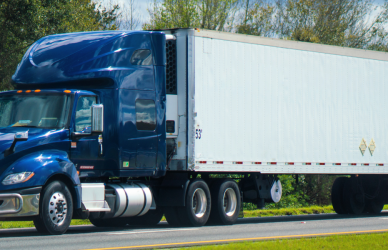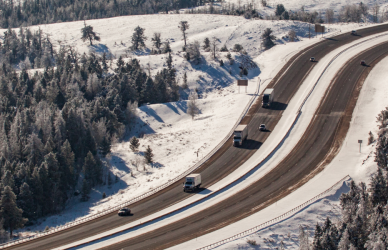Flatbed trucking is a common transportation method for oversized, heavy or irregularly shaped cargo. While flatbed trucks are versatile, cargo on these vehicles must be properly secured to prevent accidents, injuries, and cargo damage during transport. The process of securing a flatbed load is known as load securement, which involves the use of specialized equipment and adherence to government regulations. In this article, we will dive into flatbed load securement equipment and regulations that are critical for ensuring safe and successful flatbed transport.
Flatbed Load Securement Equipment:
Flatbed load securement equipment is an essential component of safe flatbed transport. There are several types of flatbed load securement equipment available, including:
Flatbed Tie-Down Straps: Flatbed tie-down straps are used to secure cargo to the flatbed deck. These straps are made of durable materials, such as polyester, and come in various lengths and widths to accommodate different cargo sizes and weights. They feature hooks, ratchets, or cam buckles for easy tension adjustment and attachment to the trailer.
Flatbed Load Bars: Flatbed load bars, also known as cargo bars or load locks, are used to prevent cargo from shifting during transport. They are adjustable and fit securely between the sidewalls of the trailer to keep cargo in place. Load bars are commonly used in combination with tie-down straps for added security.
Flatbed Load Locks: Flatbed load locks are similar to load bars but are designed to fit vertically between the trailer floor and the cargo. Load locks prevent cargo from shifting forward and backward during transport and are commonly used for lightweight loads.
Flatbed Winch Straps: Flatbed winch straps are used to secure heavy loads and come in a variety of lengths and widths. They feature hooks on one end and a winch on the other for tension adjustment. Winch straps are commonly used in combination with load bars or load locks for added security.
Flatbed Corner Protectors: Flatbed corner protectors are used to prevent cargo from damaging the corners of the trailer during transport. They are typically made of durable materials such as plastic or steel and come in various sizes and shapes.
Flatbed Load Binder: Flatbed load binders are used to secure heavy loads and are commonly used with chains. They feature ratchet mechanisms for easy tension adjustment and come in different sizes to accommodate various load weights.
Flatbed Ratchet Straps: Flatbed ratchet straps are similar to tie-down straps but feature a ratchet mechanism for easy tension adjustment. They come in various lengths and widths and are commonly used to secure heavy loads.
Flatbed Cargo Nets: Flatbed cargo nets are used to secure loose or irregularly shaped cargo. They come in different sizes and shapes and are made of durable materials such as nylon or polyester. Cargo nets feature hooks or straps for easy attachment to the trailer and can be adjusted to fit different cargo sizes.
Flatbed Chain Binders: Flatbed chain binders are used to secure heavy loads with chains. They feature a ratchet mechanism for easy tension adjustment and come in different sizes to accommodate various load weights.
Flatbed Dunnage Bags: Flatbed dunnage bags are used to fill gaps between cargo and the trailer sidewalls, preventing shifting during transport. They are typically made of durable materials such as polypropylene and come in different sizes to accommodate various cargo sizes.
Flatbed Load Tarps: Flatbed load tarps are used to protect cargo from weather conditions and debris during transport. They are made of durable materials such as vinyl or canvas and come in different sizes to accommodate various cargo sizes.
Flatbed Shoring Beams: Flatbed shoring beams are used to support heavy loads and prevent sagging during transport. They are adjustable and fit securely between the trailer walls, supporting the cargo from below.
Flatbed Edge Protectors: Flatbed edge protectors are used to protect cargo from sharp edges and corners during transport. They are typically made of durable materials such as plastic or steel and come in various sizes and shapes.
Flatbed Load Securement Regulations:
Flatbed load securement regulations are set by the Federal Motor Carrier Safety Administration (FMCSA) and Commercial Vehicle Safety Alliance (CVSA). These regulations are put in place to ensure safe and secure flatbed transport. Some of the most important regulations include:
Securing Devices: All cargo must be secured using appropriate devices, such as tie-down straps, load bars, or chains.
Load Weight Limits: Flatbed loads must not exceed weight limits set by the FMCSA.
Tie-Down Requirements: Tie-down straps must be secured around the cargo, and the tension must be adjusted to prevent movement.
Cargo Edge Protection: Cargo must be protected from sharp edges and corners using appropriate devices such as corner protectors.
Load Distribution: The load must be evenly distributed across the flatbed to prevent excess weight on one side.
Load Covering: Loads that are not waterproof must be covered with a tarp or other appropriate covering.
Following regulations and properly securing your flatbed load are critical for ensuring safe and successful flatbed transport. Proper load securement can prevent accidents, injuries, and cargo damage, protecting both the cargo and the flatbed driver. By using appropriate equipment and adhering to regulations set by the FMCSA and CVSA, flatbed drivers can transport cargo safely and securely.











